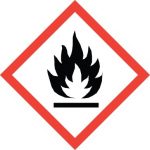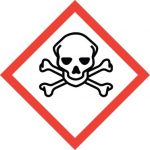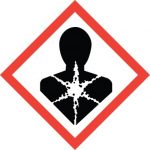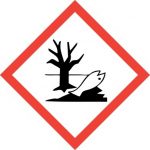1. CHEMICAL PRODUCTS & COMPANY IDENTIFICATION
Name: Uranium Dicarbide 98-100%
Supplier
IBI Labs
3495 N. Dixie Hwy. Unit # 8
Boca Raton, FL 33431
Emergency Phone Number: 561-826-0061
2. HAZARDS IDENTIFICATION
Hazards Classification
Target organs: Kidney, liver, lungs, brain.
GHS Classification
Acute toxicity, Oral (Category 2)
Acute toxicity, Inhalation (Category 2)
Specific target organ toxicity – repeated exposure (Category 2)
Acute aquatic toxicity (Category 2)
Chronic aquatic toxicity (Category 2)
GHS Label elements, Including Precautionary Statements
Pictogram
Signal word: Danger
Hazard Statements
H300 + H330 Fatal if swallowed or inhaled.
H373 May cause damage to organs through prolonged or repeated exposure.
H411 Toxic to aquatic life with long lasting effects.
H250 Catches fire spontaneously if exposed to air.
Precautionary Statements
P220 Keep/Store away from clothing/combustible materials.
P260 Do not breathe dust/fume/gas/mist/vapors/spray.
P264 Wash hands thoroughly after handling.
P273 Avoid release to environment.
P284 Wear respiratory protection.
P310 Immediately call Poison Center or doctor/physician.
Other Hazards
Radioactive
NFPA Rating
Health hazard: 3
Fire 0
Reactivity 3
CERCLA Ratings (SCALE 0-3)
Health U
Fire 0
Reactivity 3
Persistence 3
3. COMPOSITION AND INFORMATION ON INGREDIENTS
- Molecular Formula: UC2
- CAS RN: [12071-33-9]
- Chemical Family: Metal Carbides
- Appearance: UC is usually a dull, dark charcoal gray, or flat, black-colored powder or chunks with no detectable odor.
- Molecular Weight: 262.05
- Boiling Point: 4370°C
- Melting point: >>2350°C
- Density: 11.28 16
- Water Solubility: Insoluble
- Reactions: Radioactive solid that is strongly electropositive. On vigorous shaking the metallic particles exhibit luminescence. It can ignite.
The half-lives of the various uranium isotopes are as follows:
233U = 1.59 X 105 y; 234U = 2.47 X 105 y; 235U = 7.04 X 108 y; 236U = 2.39 X 107 y;
238U = 4.51 X 109 y.
The specific activities of the various uranium isotopes are as follows:
233U = 3.6 X 102 MBq/g (9.7 X 10-3 Ci/g)
234U = 2.3 X 102 MBq/g (6.2 X 10-3 Ci/g)
235U = 7.8 X 10-2 MBq/g (2.1 X 10-6 Ci/g)
236U = 2.3 MBq/g (6.3 X 10-5 Ci/g)
238U = 1.2 X 10-2 MBq/g (3.3 X 10-7 Ci/g)
See 10 CFR Chapter 1, Pt. 71, Appendix A.
4. FIRST AID MEASURES
Necessary First Aid Measures: Indication of Immediate Medical Attention: In all routes of exposure, seek medical treatment immediately. Medical problems take priority over radiologic concerns. See treatment/first-aid measures below.
- Inhalation: Remove to fresh air. If breathing becomes difficult, call a physician.
- Ingestion: If ingested, wash the mouth with water provided the person is conscious. Call a physician.
- Skin contact: In case of contact, immediately wash the skin with soap and copious amounts of water.
- Eye contact: In case of contact with eyes, flush with copious amounts of water for at least 20 minutes. Assure adequate flushing by separating the eyelids with fingers. Call a physician.
Most important symptoms and effects, acute and delayed: Uranium is a nephrotoxin, damaging the kidneys. Uranium is a skin, eye, and mucous membrane irritant.
5. FIREFIGHTING MEASURES
- Suitable extinguishing media: Dry chemical, carbon dioxide, water spray, or regular foam.
- Fire and explosion hazard: Dangerous fire hazard when exposed to heat or flame. Dangerous explosion hazard when exposed to heat or flame. Pyrophoric.
- Hazardous combustion products: Thermal decomposition may release toxic and/or hazardous gases.
Special protective equipment and precautions for firefighters: Move the container from the fire area if you can do it without risk. Wear a self-contained breathing apparatus if necessary. Apply cooling water to the sides of containers exposed to flames until well after the fire is out. Do not move damaged containers; move undamaged containers out of the fire zone. For massive fires in the cargo area, use an unmanned hose holder or monitor nozzles. Contact the local, State, or Department of Energy radiological response team. Use suitable agents for surrounding fire. Cool containers with flooding amounts of water, apply from as far a distance as possible. Avoid breathing dust or vapor, keep upwind. Keep unnecessary people out of the area until declared safe by the radiological response team.
6. ACCIDENTAL RELEASE MEASURES
Personal precautions and protective equipment: Avoid contact with eyes, skin, and clothing. Avoid breathing dust. Wear respiratory protection, gloves, overgarments, and goggles. Evacuate personnel to safe areas.
Emergency procedures for containment and clean-up: Do not touch damaged containers or spilled material. Damage to the outer container may not affect the primary inner container. For small liquid spills, take up with sand, earth, or other absorbent material. For large spills, dike far ahead of the spill for later disposal. Keep unnecessary people at least 150 feet upwind; greater distances may be necessary if advised by a qualified radiation authority. Isolate the hazard area and deny entry. Enter the spill area only to save life, limit entry to the shortest possible time. Detain uninjured persons and equipment exposed to radioactive material until arrival or instruction of qualified radiation authority. Delay cleanup until arrival or instruction of qualified radiation authority.
7. HANDLING AND STORAGE
Precautions for safe handling: Avoid contact with skin and eyes. wash hands thoroughly after handling.
Conditions for safe storage: Store in the radioactive materials area. Keep the container tightly closed. Store separately from incompatible materials. Observe all Federal, State, and local regulations when storing this substance.
8. EXPOSURE CONTROLS AND PERSONAL PROTECTION
Exposure Limits
URANIUM DICARBIDE, INSOLUBLE COMPOUNDS (As U):
0.2 mg/m3 OSHA TWA; 0.6 mg/m3 OSHA STEL
0.2 mg/m3 ACGIH TWA; 0.6 mg/m3 ACGIH STEL
0.2 mg/m3 NIOSH Recommended TWA; 0.6 mg/m3 NIOSH Recommended
STEL
Occupational exposure to radioactive substances must adhere to standards established by the Occupational Safety and Health Administration., 29 CFR 1910.96, and/or the Nuclear Regulatory Commission, 10 CFR Part 20. IF purchased by DOE or DOE-governed facilities subject to 10 CFR 835. Subject to foreign entity radiation protection regulations.
Ventilation: At a minimum, provide local exhaust or process enclosure ventilation. One method of controlling external radiation exposure is to provide adequate shielding. The absorbing material used, and the thickness required to attenuate the radiation to acceptable levels depends on the type of radiation, its energy, the flux, and the dimensions of the source.
- Alpha particles: For the energy range of alpha particles usually encountered, a fraction of a millimeter of any ordinary material or a few inches of air is sufficient for absorbency. Rubber, cardboard, or any such material will suffice.
- Beta particles: Beta particles are more penetrating than alpha and require more shielding. Materials composed mostly of elements of low atomic number such as acrylic, aluminum, and thick rubber are most appropriate for the absorption of beta particles. With high-energy beta radiation from large sources, Bremsstrahlung (X-ray production) contribution may become significant, and it may be necessary to provide additional shielding of high atomic weight material, such as lead, to attenuate the Bremsstrahlung radiation. In the quantities shipped, Certified Reference Materials will not emit significant amounts of beta particles.
- Gamma rays: The most suitable materials shielding gamma radiation are lead and iron. Normal and depleted uranium is not normally considered gamma emitters. In the quantity shipped, enriched Certified Reference Materials will pose only a negligible gamma hazard.
Clothing, gloves, and eye protection equipment will protect against alpha particles.
Eye protection: Employees must wear appropriate eye protection that will not allow the introduction of particles into the eyes. Contact lenses should not be worn.
Clothing: Disposable over-garments, including head coverings and foot covering, should be worn by any employee engaged in handling any radioactive substance. These garments are also recommended even if the employee is working with a “glove box” containment system.
In the event of an accident, full protective clothing will be necessary.
Gloves: Employees must wear appropriate protective gloves to prevent contact with this substance. Used gloves may be contaminated and should be disposed of as radioactive waste.
Respirator: The following respirators and maximum use concentrations are recommendations by the U.S. Department of Health and Human Services, NIOSH pocket guide to chemical hazards; NIOSH criteria documents or by the U.S. Department of Labor, 29 CFR 1910 Subpart Z.
The specific respirator selected must be based on contamination levels found in the workplace, must not exceed the working limits of the respirator, and jointly be approved by the National Institute for Occupational Safety and Health and the Mine Safety and Health Administration (NIOSH-MSHA).
URANIUM, Insoluble Compounds (As U)
At any detectable concentration: Any self-contained breathing apparatus with a full facepiece operated in a pressure-demand or other positive-pressure mode.
Any supplied-air respirator with a full facepiece operated in a pressure-demand or other positive-pressure mode or other positive-pressure mode with an auxiliary self-contained breathing apparatus operated in pressure-demand or other positive-pressure mode.
Escape – any air-purifying, full-facepiece respirator with a high-efficiency particulate filler.
Any appropriate escape-type, self-contained breathing apparatus.
For Firefighting and Other Immediately Dangerous to Life or Health Conditions
Any self-contained breathing apparatus with a full facepiece respirator and a high-efficiency particulate filter.
Any supplied-air respirator with a full facepiece operated in a pressure-demand or other positive-pressure mode or other positive-pressure mode with an auxiliary self-contained breathing apparatus operated in pressure-demand or other positive-pressure mode.
Potential Health Effects
- Inhalation
Short-term exposure: This may cause lack of appetite, nausea, vomiting, diarrhea, dehydration, kidney damage, blood in the urine, jaundice, weakness, drowsiness, incoordination, twitching, sterility, blood disorders, convulsions, and shock. Exposure to radioactive substances increases one’s risk of developing cancer.
Long-term effects: In addition to effects from short-term exposure, anemia, cataracts, and lung damage may occur.
- Skin
Short-term exposure: No information available on significant adverse effects.
Long-term effects: May cause skin irritation.
- Eyes
Short-term exposure: May irritate. Additionally, eye damage, including ulceration, may occur.
Long-term effects: It is unlikely that long-term eye contact would occur as the effects of
Short-term exposure, over a period, would result in serious eye damage. However, if long-term exposure did occur, cataracts may also occur.
- Ingestion
Short-term exposure: May cause kidney damage. May cause increased cancer risk.
Long-term effects: Same effects as short-term exposure.
Carcinogen Status
OSHA: N
NTP: N
IARC: N
9. STABILITY AND REACTIVITY
Chemical stability: Uranium Carbide powder or chunks oxidize readily in air. If confined in a container without air movement, they can ignite spontaneously. Moisture increases this reactivity.
Uranium carbide stored in water will form a hydride and ignite during warm weather.
Conditions to avoid: May ignite itself if exposed to air. May burn rapidly with a flare-burning effect and re-ignite after the fire is extinguished.
- Chlorine: Violent reaction, ignites at 150-180°C.
- Air: Violent reaction.
- Fluorine: Violent reaction.
- Nitric Acid: Reacts explosively or with the formation of an explosive surface coating or residue.
- Nitrogen Oxide: Ignites.
- Dinitrogen Tetroxide: Explodes or forms an explosive surface coating or residue.
- Selenium and Sulfur: React violently or incandesces.
- Water: Violent reaction hazard.
- Ammonia: Reacts violently or incandesces at dull red heat.
- Bromium Trifluoride: Violent reaction
- Trichloro Ethylene: Violent reaction
- Nitryl fluoride: Violent reaction or glowing or white incandescence.
- Carbon Dioxide: At 750°C Interaction is so rapid that ignition will occur with the finely divided metal, and at 800°C the massive metal will ignite.
- Carbon Tetrachloride: The use of a carbon tetrachloride fire extinguisher on a small uranium fire led to an explosion.
- Bromine Vapor: Ignites at 210-240°C.
- Iodine Vapor: Ignites at 260°C.
- Acids: Reacts with the liberation of hydrogen and the formation of salts of tetravalent uranium.
- Hazardous decomposition products: Thermal decomposition may release toxic and hazardous gases.
10. TOXICOLOGY INFORMATION
URANIUM
Carcinogenicity
Contains a radioactive isotope that may produce cancer and genetic mutation.
IARC: No chemical component of this product present at levels greater than or equal to 0.1% is identified as probable, possible, or confirmed human carcinogen by IARC.
NTP: No chemical component of this product present at levels greater than or equal to 0.1% is identified as a known or anticipated carcinogen by NTP.
OSHA: No chemical component of this product present at levels greater than or equal to 0.1% is identified as a carcinogen or potential carcinogen by OSHA.
Carcinogen Status
Not carcinogenic as a chemical. Ionizing radiation is carcinogenic.
The toxicity of uranium metal has not been quantified. Uranium may be a skin, eye, and mucous membrane irritant, as well as a nephrotoxin. Uranium metal usually does not constitute an external radiation exposure hazard since it emits mainly alpha radiation at a low energy level. It may constitute an internal radiation hazard if it is absorbed into the body, thus delivering alpha emission onto tissues in which it is stored.
Health Effects
- Inhalation
Uranium
Radioactive/Nephrotoxin .30 mg/m3 is immediately dangerous to life and health.
Acute exposure: Uranium may enter the body through inhalation of fine particles that are approximately 1 micron in diameter. Uranium poisoning is characterized by generalized health impairment. It may cause changes in the kidneys, liver, lungs, cardiovascular, nervous, and hemopoietic systems, and disorders of protein and carbohydrate metabolism. Symptoms may include oliguria, hematuria, albuminuria, and jaundice.
Chronic exposure: Workers exposed to high average levels of uranium dust in a plant at Oak Ridge have not had increased mortality rates from lung cancer, leukemia, bone cancer, or diseases of the respiratory and genitourinary systems. Lung cancer in uranium miners is probably the result of inhalation of radon daughters found in these mines. Chronic poisoning gives chest findings of pneumoconiosis, pronounced blood changes, and generalized injury. Cancer or lymphatic and blood-forming tissues may result. See the following sections regarding the effects of inhalation of an alpha emitter.
Alpha Radiation
Acute exposure: Alpha radiation is densely ionizing with very high energy and will kill cells immediately adjacent to the source of contact. Damaged cells may not recover or be repaired. Alpha emitters may or may not be absorbed, depending on the solubility and particle size. Insoluble compounds may remain at or near the site of deposition, and soluble compounds may rapidly enter the bloodstream. Heavier particles will be brought up to the throat by ciliary action and may then be ingested. The lighter particles may be lodged deep in the alveolar air sacs and remain. The damage depends on how quickly they are eliminated, and the susceptibility of the tissue in which they are stored. A single large dose of radiation may lead to increased cancer risk.
Chronic exposure: The effects of chronic exposure by internally deposited alpha radiation are dependent upon the dose and target organ(a). Possible disorders include lung cancer, sterility, anemia, leukemia, or bone cancer.
The delayed effects of radiation may be due either to a single large overexposure or continuing low-level overexposure and may include cancer, genetic effects, shortening of life span, and cataracts. Cancer is observed most frequently in the hematopoietic system, thyroid, bone, and skin. Leukemia is among the most likely forms of malignancy. Lung cancer may also occur due to radioactive materials residing in the lungs. Genetic effects may range from point mutations to severe chromosome damage such as strand breakage, translocations, and deletions. If the germ cells have been affected, the effects of the mutation may not become apparent until the next generation, or even later.
- Skin contact
Uranium
Radioactive
Acute Exposure: There is no evidence that insoluble uranium compounds can be absorbed through the skin, insoluble salts didn’t produce any signs of poisoning after skin contact. Uranium may irritate the skin.
Chronic Exposure: Prolonged skin contact with insoluble uranium compounds should be avoided because of potential radiation damage to basal cells. Dermatitis has occurred because of handling some insoluble uranium compounds.
Alpha radiation
Acute exposure: Alpha radiation is not usually an external hazard. However, local damage may occur at the site of the wound. Absorption or penetration through damaged skin may result in increased cancer risk.
Chronic exposure: Prolonged or repeated contact may result in increased cancer risk.
- Eye contact
Uranium
Radioactive
Acute exposure: Dust may be irritating to the eyes. A variety of soluble and insoluble compounds or uranium were tested on the eyes of rabbits. The insoluble compounds caused the mildest degree of injury. The effects of eye contact with any uranium compound tend to be necrosis of the conjunctivae and eyelids and ulceration of the cornea.
Chronic exposure: Prolonged exposure to uranium may produce conjunctivitis, or the symptoms of radiation injury, such as cataracts. See the following sections regarding the effects of alpha radiation on the eyes.
Alpha radiation
Acute exposure: Radiation affects the eye by inducing acute inflammation of the conjunctiva and the cornea. The most sensitive part of the eye is the crystalline lens. A late effect of eye irradiation is cataract formation. It may begin anywhere from 6 months to several years after a single exposure. Cataract formation begins at the posterior pole of the lens and continues until the entire lens has been affected. Growth of the opacity may stop at any point. The rate of growth and the degree of opacity are dependent upon the dose of radiation.
Chronic exposure: Repeated or prolonged exposure to alpha radiation may result in cataract formation, as described above. Of the well-documented late effects of radiation on man, leukemia, and cataracts have been observed at doses lower than those producing skin scarring and cancer or bone tumors. The lens of the eye should be a critical organ.
- Ingestion
Uranium
Radioactive/Nephrotoxin
Acute exposure: Feeding studies on animals indicate that insoluble uranium is much less toxic than soluble uranium compounds. Uranium entering the bloodstream will become stored in the bone marrow, but the majority will become lodged in the kidney, which is the major site of toxicity. More than a year and a half are required to rid the body of an accidental high dose of uranium, after which time measurable uranium is present in the bone and kidney.
Chronic exposure: The toxic action of uranium resides more in its chemical action on the renal tubules, rather than radiation effects. Rats injected with uranium metal in the femoral marrow developed sarcomas, whether this was due to metallo carcinogenic or radio carcinogenic ingestion of alpha emitters. Also, see the first aid section for uranium compounds.
Alpha radiation
Acute exposure: The fate of ingested alpha emitters depends on their solubility and valence.
Chronic exposure: Repeated ingestion of alpha emitters may increase cancer risks.
First Aid for Uranium Compounds
Although chelating agents act on uranium, they should not be used because the increased migrant fraction leads through renal precipitation to a greater kidney burden than would be received if there were no treatment at all; there is thus the risk of serious toxic nephritis. The basic treatment should be the administration of a bi-carbonated solution given locally and in intravenous perfusion (one bottle of 250 ML at 1.4%).
11. DISPOSAL INFORMATION
Observe all Federal, State, and local Regulations when disposing of this substance.
12. TRANSPORTATION INFORMATION
The U.S. Department of Transportation (D.O.T.) Code of Federal Regulations (49 CFR Parts 100-185), the International Air Transportation Association (IATA), the International Civil Aviation Organization (ICAO), and the International Maritime Organization (IMDG) are all factored into the classification and transport of material.
Proper Shipping Name:
Hazard Class:
UN/ID Number: To be determined on a case-by-case basis.
Special Information:
Packing Group:
The classification of substances with multiple hazards must be determined following the criteria presented in the regulations mentioned above. Due to the various quantities and combinations of materials being shipped at one time, the information above must be determined based on the characteristics of the specific shipment.
13. REGULATORY INFORMATION
TSCA STATUS: Y
CERCLA SECTION 103 (40 CFR 302.4): N
SARA SECTION 302 (40 CFR 355.30): N
SARA SECTION 304 (40 CFR 355.40): N
SARA SECTION 313 (40 CFR 372.65): N
OSHA PROCESS SAFETY (29 CFR 1910.119): N
CALIFORNIA PROPOSITION 65: N
SARA HAZARD CATEGORIES, SARA SECTIONS 311/312 (40 CFR 370.21)
ACUTE HAZARD: Y
CHRONIC HAZARD: Y
FIRE HAZARD: Y
REACTIVITY HAZARD: Y
SUDDEN RELEASE HAZARD: Y
14. OTHER INFORMATION
Copyright 2014 IBI Labs. License granted to make unlimited paper copies for internal use only.
IBI Labs requires that those who receive their materials comply with 29 CFR 1910.1200(h), which mandates that employers provide employees with effective information and training about hazardous chemicals in their workplace.
The contents of this document are believed to be accurate as of the date of revision and are provided in good faith. However, it is recommended that recipients use this information as supplementary and exercise caution and judgment regarding its accuracy and suitability. Please note that IBI Labs cannot accept responsibility for any indirect, incidental, or consequential damage resulting from the use of the information provided in this Safety Data Sheet.
IBI Labs makes no warranties, expressed or implied, including warranties of merchantability and fitness for a particular purpose. This information is provided without warranty, and any use of the product that does not conform to this Safety Data Sheet, or that is used in combination with any other product or process, is the responsibility of the user.
Revision Date: 04/18/2024





